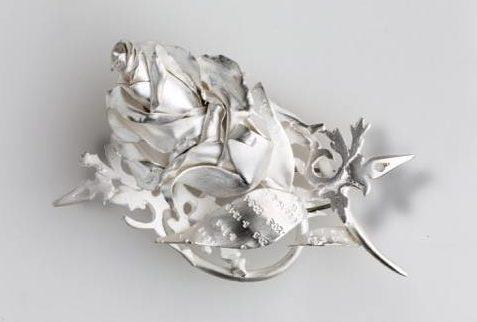A realm of limitless white space, white noise and silvery-snowfall is the result of months of craftsmanship and dedication by artist Steven Kaplan-Pistiner.
Kaplan-Pistiner mainly works with metals to create jewelry but it’s clear his pieces contain more than just an aesthetic element. Undertones of general history, personal stories and loss are clearly present in this collection.
As an undergraduate at the University of Wisconsin, Kaplan-Pistiner started his education as a business major, but realized while sitting in those classes what he really wanted was to pursue an art degree. Kaplan-Pistiner has worked on his senior thesis since early September, but the ideas for the exhibition have been floating around in his head for a while, Kaplan-Pistiner said.
The title of his exhibition “like shouting in a snowstorm” is inspired by winter memories from his childhood, such as when the ground and the sky would meet to create a pure white space or the amplified crunch of shoes walking on fresh snowfall. It also started as an “emotional gestalt,” Kaplan-Pistiner said.
“Playing outside wasn’t limited to time or imagination,” Kaplan-Pistiner said. “It was limited by how long it would take for the blood to slow down in your veins.”
The introspection goes even deeper than childhood memories for him. Loss is a central point for this exhibition, whether it be the loss of a close friend last spring or channeling stories from his late grandfather, who was held in a concentration camp during World War II. These losses play as an emotional underpinning for every aspect of his work.
With writing being one of his generative processes, Kaplan-Pistiner kept finding the phrase “shouting in a snowstorm” came up the most. He decided to use his thesis to display how history and ornamentation work back and forth.
One of his main goals in showing this is to take something known for its historical or empirical significance and strip it of that. Propaganda, such as jewelry and flags, are ways for countries or regimes to claim their identity.
One of his pieces, “for when the wind stops your breathing,” is inspired by a World War II Nazi war medal. It has layers of silver patterns. Instead of displaying a flag there’s a white piece of fabric, almost representing a sort of surrender.
“I set up a three-prong comparison to create a dynamic between the hyperpersonal and the historic all kind of existing within the metaphor of a snowstorm,” Kaplan-Pistiner said.
These adornments are important to him because jewelry can function as a conversation starter or a way for an individual to present themselves to the world. All of his work is wearable.
The medium of metals works best for Kaplan-Pistiner to communicate his message to the world, and every piece of his work is handmade. The silver pieces of jewelry on display will float above their pedestals as an imitation of geological permanence and art history. These pedestals have a marble appearance to comment on how such sculpture is considered to be the pinnacle of three-dimensional art.
When people look at his art, Kaplan-Pistiner said he wants them to be contemplative within themselves and their past experiences. He wants them to “look at these objects, whether they be a memento or monumental,” and “to be able to focus on one small thing in a world where we’re constantly moving.”
“Each medium, for me, is intertwined in my thinking process, and they all fulfill different ends,” he said.
It’s clear tremendous thought and effort is behind every single piece of this exhibit. The prints are his unique work, all of the pedestals are handmade as are the metals. Almost everything is pure white recycled silver.
When he melts these recycled metals, he said it’s like taking all of this jewelry that have stories, memories and personalities attached to them and transforming them into something else that’s meant to exist in the world.


